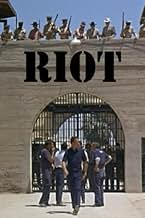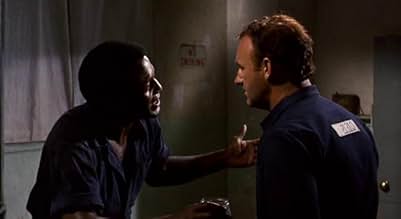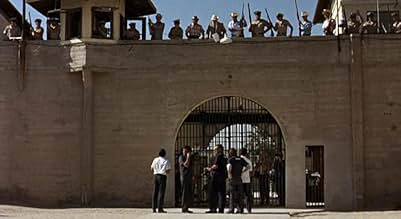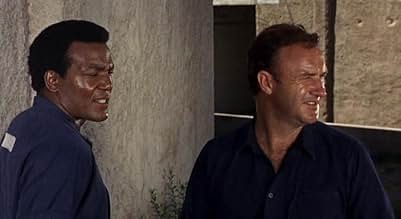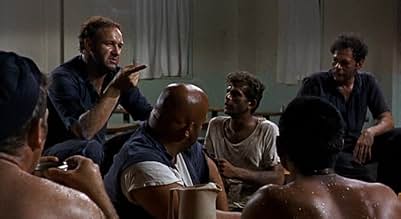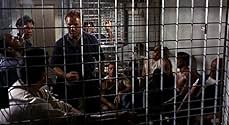A riot in a state prison is staged to cover up an escape attempt, during which many inmates and guards are killed. Shot on location at Arizona State Prison.A riot in a state prison is staged to cover up an escape attempt, during which many inmates and guards are killed. Shot on location at Arizona State Prison.A riot in a state prison is staged to cover up an escape attempt, during which many inmates and guards are killed. Shot on location at Arizona State Prison.
- Director
- Writers
- All cast & crew
- Production, box office & more at IMDbPro
Featured review
I realized in time for his centenary tribute that this tense jailbreak thriller was produced by William Castle; the film does not have much of a reputation, however, and is perhaps most notable for being one of a number of transitory parts for Gene Hackman between his acquiring fame in BONNIE AND CLYDE (1967) and stardom via THE FRENCH CONNECTION (1971) – another such effort, THE SPLIT (1968), had partnered him with Jim Brown (who also assumes the leading role here). Indeed, Hackman's superiority in the acting stakes – despite essentially playing second- fiddle to ex-American Football luminary Brown – in comparison to the other participants (more on this later) is palpable throughout. Having said that, Gerald S. O'Loughlin is initially set out as the prisoners' chief nemesis but his contribution gradually diminishes once the titular event takes centre-stage.
The movie is basically an updated and more brutal version of earlier prison dramas, the obvious prototype being Don Siegel's noir classic RIOT IN CELL BLOCK 11 (1954). What is interesting in this case is that the riot is borne out of an attempted mass escape of the isolation division; when the latter is foiled, mastermind Hackman decides to buy some time – ostensibly negotiating system reforms with the authorities on the outside (as it happens, the fearsome warden has chosen this precise moment to take a break!) – while a tunnel is being laboriously dug from under the auditorium to freedom just past the walls of the vast compound!! Incidentally, Castle is to be commended for shooting this in an authentic Arizona correctional facility – with not only the real-life warden filling his respective shoes within the narrative (I wonder whether he was aware of how unsympathetically his office was being depicted!) but also a number of the convicts themselves!!
As I said, the film features a number of contemporary trappings which, frankly, do it (and even more so the genre involved) no more than a disservice – notably a substance-fuelled party by the inmates, with a handful of them in drag so as to titillate their 'colleagues'; one of them even invites coloured macho Brown to his cell, but he obviously backs off (preferring to envision a clutch of bikini-clad 'sisters' in the movie's one scene with female presences, drooling over him)! Similarly over-the-top are the actions of a wacky knife-happy Indian who constantly antagonizes Brown, and whom Hackman needs tagging along in order to supply guidance in their eventual flight to Mexico only to have his throat memorably slit by him at their very moment of glory (many of the intended fugitives had already been routed by the shrewd warden)! Among the assets, then, are the pristine DVD-sourced look and Krzysztof Komeda's unusual score (albeit backed by a recurring wistful ballad that acts as Brown's theme tune), the esteemed Polish composer's last effort prior to his untimely tragic death – and which ties the picture with Castle's much more distinguished production ROSEMARY'S BABY (1968).
The movie is basically an updated and more brutal version of earlier prison dramas, the obvious prototype being Don Siegel's noir classic RIOT IN CELL BLOCK 11 (1954). What is interesting in this case is that the riot is borne out of an attempted mass escape of the isolation division; when the latter is foiled, mastermind Hackman decides to buy some time – ostensibly negotiating system reforms with the authorities on the outside (as it happens, the fearsome warden has chosen this precise moment to take a break!) – while a tunnel is being laboriously dug from under the auditorium to freedom just past the walls of the vast compound!! Incidentally, Castle is to be commended for shooting this in an authentic Arizona correctional facility – with not only the real-life warden filling his respective shoes within the narrative (I wonder whether he was aware of how unsympathetically his office was being depicted!) but also a number of the convicts themselves!!
As I said, the film features a number of contemporary trappings which, frankly, do it (and even more so the genre involved) no more than a disservice – notably a substance-fuelled party by the inmates, with a handful of them in drag so as to titillate their 'colleagues'; one of them even invites coloured macho Brown to his cell, but he obviously backs off (preferring to envision a clutch of bikini-clad 'sisters' in the movie's one scene with female presences, drooling over him)! Similarly over-the-top are the actions of a wacky knife-happy Indian who constantly antagonizes Brown, and whom Hackman needs tagging along in order to supply guidance in their eventual flight to Mexico only to have his throat memorably slit by him at their very moment of glory (many of the intended fugitives had already been routed by the shrewd warden)! Among the assets, then, are the pristine DVD-sourced look and Krzysztof Komeda's unusual score (albeit backed by a recurring wistful ballad that acts as Brown's theme tune), the esteemed Polish composer's last effort prior to his untimely tragic death – and which ties the picture with Castle's much more distinguished production ROSEMARY'S BABY (1968).
- Bunuel1976
- May 1, 2014
- Permalink
Storyline
Did you know
- TriviaArizona State Penitentiary warden Frank Eyman and 600 inmates and prison staff appear in the movie.
- Alternate versionsAn edited, "PG" rated version was released to theaters in 1970. Video version is the complete "R" rated version.
- ConnectionsReferenced in Summer in the City (1971)
- SoundtracksRAG MOP
Words and Music by Johnny Lee Wills and Deacon Anderson
- How long is Riot?Powered by Alexa
Details
Contribute to this page
Suggest an edit or add missing content









